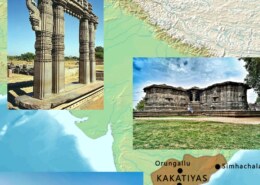Roadmap for Answer Writing 1. Introduction Objective: Introduce the topic and highlight the cultural importance of lion and bull figures in Indian society. Key Points: Brief overview of their roles in mythology, art, and architecture. 2. The Lion as a Symbol in Indian Culture A. ...
Model Answer Introduction Gandhara art is renowned for its unique fusion of Indian, Central Asian, and Greco-Bactrian elements. This syncretic art form emerged during the cultural interactions following the conquests of Alexander the Great, the rise of the Greco-Bactrian Kingdom, and the influence oRead more
Model Answer
Introduction
Gandhara art is renowned for its unique fusion of Indian, Central Asian, and Greco-Bactrian elements. This syncretic art form emerged during the cultural interactions following the conquests of Alexander the Great, the rise of the Greco-Bactrian Kingdom, and the influence of the Kushan Empire.
Hellenistic Influence
One of the most prominent features of Gandhara art is its Hellenistic influence. The art showcases realistic human proportions, naturalistic facial expressions, and intricate drapery. For instance, the standing Buddha statues from Gandhara exhibit Hellenistic drapery and lifelike facial expressions, reflecting a departure from earlier, more rigid styles.
Depictions of Buddha
The anthropomorphic representation of the Buddha in Gandhara art illustrates Greco-Bactrian influence, particularly in stylistic details such as wavy hair, a topknot, and distinct facial features. A notable example is the Fasting Buddha, which captures these features, merging local traditions with Greco-Bactrian aesthetics.
Architectural Elements
Gandhara’s architectural characteristics also reveal Central Asian and Greco-Bactrian influences. The use of Corinthian capitals in Buddhist stupas and monasteries is a striking feature. The Dharmarajika Stupa in Taxila exemplifies this blend, showcasing architectural styles that reflect cultural exchanges.
Motifs and Iconography
Gandhara art incorporates motifs and iconography from both Greco-Bactrian and Central Asian cultures. Mythological figures and scenes from Greek and Central Asian mythology are prevalent, such as sculptures of Atlas supporting the Buddha’s throne and depictions of Hercules, highlighting the artistic dialogue between cultures.
Materials and Techniques
Gandhara artists utilized materials like grey schist and stucco, indicative of Central Asian and Greco-Bactrian influences. The Bimaran casket, made of gold and encrusted with jewels, is a prime example of the craftsmanship and material culture of this region.
Conclusion
Gandhara art stands as a testament to the rich cultural exchanges among India, Central Asia, and the Greco-Bactrian region. The unique fusion of these elements exemplifies the syncretic nature of the period and underscores the interconnectedness of diverse cultures in creating enduring artistic expressions.
See less

Model Answer Introduction The lion and bull figures are significant symbols in Indian mythology, art, and architecture, embodying profound cultural meanings. These animals have been depicted in various artistic forms, showcasing their importance in representing strength, power, and prosperity. The LRead more
Model Answer
Introduction
The lion and bull figures are significant symbols in Indian mythology, art, and architecture, embodying profound cultural meanings. These animals have been depicted in various artistic forms, showcasing their importance in representing strength, power, and prosperity.
The Lion as a Sign of Power and Royalty in India
The lion, often referred to as the king of the jungle, symbolizes strength, courage, and ferocity. In Indian mythology, it serves as the mount of powerful deities like Goddess Durga and Lord Vishnu. The lion is frequently depicted as a symbol of royal authority and divine protection. A prominent example is the Ashoka Pillar, featuring four lions seated back to back, which represents power, courage, and confidence. This emblematic representation underscores the lion’s role in asserting the might of the Mauryan Empire (Source: Indian Art and Architecture by T. Richard Blurton).
The Bull as a Symbol of Fertility and Prosperity in India
Conversely, the bull is associated with fertility, abundance, and agricultural strength. It is closely linked to Lord Shiva, who is often seen riding a bull named Nandi, revered as the gatekeeper of Shiva’s abode. In agricultural contexts, bulls are essential for ploughing fields, thus symbolizing fertility and prosperity within rural life. This connection highlights the bull’s role in sustaining agricultural practices and community livelihoods (Source: The Sacred Cow: Symbol of Abundance by C. G. W. R. Patil).
Significance in Art and Architecture
Both lion and bull figures have been extensively used in Indian art and architecture. The Khajuraho temples, for instance, exhibit intricate sculptures of lions and bulls, capturing their strength and grace (Source: Khajuraho: The Temples of Love by K. C. Jain). Furthermore, forts and palaces across India, such as the Red Fort in Delhi and Mehrangarh Fort in Jodhpur, feature lion and bull sculptures that signify the power and might of their rulers.
Conclusion
The lion and bull figures symbolize strength, power, and prosperity, deeply rooted in Indian culture. Their representation in mythology, art, and architecture reflects enduring traditions and beliefs that continue to resonate through generations.
See less